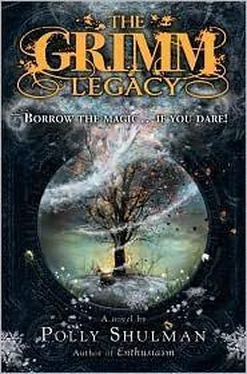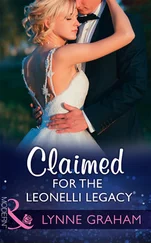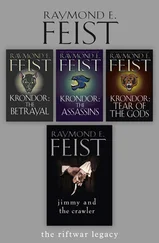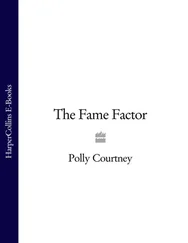“Anjali!” called Aaron again. “You still back there?”
“Just a moment, I’ll be right there!” she yelled back. She looked worried and impatient. “I can’t explain now,” she told me. “Listen, though, this is important. Don’t touch anything! That stuff looks harmless, but a lot of it’s seriously dangerous.”
“I’ll be careful,” I promised.
“Good. Now hurry. But don’t get caught! If you do, blame me—say I told you Doc wanted you to do it. I’ll back you up, and there’s a chance they’ll believe us. But please, don’t get caught.”
“Anjali?” Aaron loomed toward us through the gloom. “Ms. Minnian needs that hand truck. I can help you bring it up if you want.”
“I’m coming,” she said. “Thanks a million, Elizabeth, I owe you,” she whispered, and followed Aaron down the hallway.
Then I was left alone with the mysterious boots. Clipping the barrette in my hair for safekeeping, I twisted one of the timers that controlled the lights. To the sound of its buzzy ticking, I took the boots out of their bag to get a better look. There was nothing much to see: a pair of plain brown leather boots, old-fashioned, a little scuffed, the heels worn. Much too big for me, probably, if Marc could wear them—I have big feet for a girl, to my sorrow, but nowhere near as big as a basketball player’s. But when I held the boots up to my feet, they looked as if they might fit. Weird. I was tempted to try them on to see, but the ticking of the light timer reminded me that Anjali had said to hurry. On an impulse, I brought the boots up to my nose the way the patron had done upstairs, scolding myself as I did it: Eww, Elizabeth, what’s the matter with you, sniffing old boots?
To my surprise, I smelled something.
Well, I had expected to smell something —old leather, old wool, maybe old feet—but not this. The smell was faint, but the sensation was powerful, flooding over me like a memory of . . . of what, though? Summer rain on cement? Rye toast at my grandmother’s? Something floral and fragile, like individual soap bubbles . . . no, something thick, like milk . . . but briny . . . no, lemony . . . I took deeper and deeper sniffs, chasing the smell farther and farther out of my mind’s reach like a splinter you pursue hopelessly through the sole of your foot with a needle and tweezers. The sensation was almost as painful. Raw oysters? Marjoram? Jet exhaust? Wood?
The timer ticked its way to the end and the light snapped off, startling me with darkness. I stuffed the boots in their bag and hurried down to Stack 1, the Dungeon.
I expected something spooky, but despite its sinister name, Stack 1 looked bright and ordinary—far less dungeony than Stack 2. Fluorescent tubes lit the aisles, humming slightly, as if bored. The usual metal cabinets stretched out to the right and left, interspersed with the usual file drawers and oak desks. The dumbwaiters whirred at the staging area, just as they did on all the other stacks, and the occasional pneum thumped through the tubes. The only difference I could see between the Dungeon and the rest of the library stacks was a number of areas fenced off with metal gratings, like the bicycle storage locker in the basement of my old school, and some closed doors.
A coat hung on a hook in the staging area, but there was nobody in sight. I’d better put the boots away before whoever it was came back, I thought. But which way was the Grimm Collection? I checked the wall map. There were several rooms marked off at the ends of the stack, like the *Vs on the other floors: *GChr, *LC, *GoS . . . There, that must be it, *GC, at the far west end. I hurried down the aisle.
I half expected to find a spectacular entrance in the spirit of the Tiffany windows and the carved front desk, but the door to the Grimm Collection was as unremarkable as the rest of the stack. Just a plain metal door like all the others, rather scuffed, with *GC Grimm Coll stenciled on it in shiny black paint.
I pressed down on the handle—it was the standard bar type, the kind they use to make doors easier to open for people with disabilities—but it wouldn’t budge. Feeling foolish, I took the barrette out of my hair and pressed it against the door. “Out is out and shut is shut, turn the key and break the nut. Push the door and crack the shell: let me in and all is well , ” I sang under my breath.
I tried the handle again. Nothing happened.
I sang it again, louder. Still nothing.
Was Anjali playing some kind of mean trick on me? But she had sounded so sincere, so genuinely panicked. Hearing footsteps in the aisle, I started to panic myself.
I was pretty sure I’d gotten the tune right. Maybe I’d gotten the rhyme mixed up? I got out the slip of paper to check.
“Out is out and shut is shut,” I sang, my hand on the handle. “Turn the key and crack the nut. Push the door and break the shell: let me in and all is well.”
This time I felt a tiny click. When I pressed the handle, the door opened, just as it was supposed to. I slipped in and pulled the door shut behind me.
The room looked ordinary, with the same standard-issue metal shelves and cabinets as the rest of the library, the same fluorescent lights. And yet something was different here. Behind the usual buzz of the fluorescent lights and the pneumatic tubes, I heard another, deeper hum.
Then I noticed the smell. It was the same smell I’d noticed in the boots. Or was it? I stood just inside the door sniffing the air, mesmerized. Raw pumpkin? Mineral oil? Blood?
A pneum whizzed through a pipe in the ceiling, startling me. I remembered what I was doing there. I had boots to shelve and no time to lose.
The shoe section—*GC 391.413-391.413099—filled a whole aisle. Those Grimm brothers, or whoever had continued their collection, apparently had quite a thing for footwear. Most of it was in pretty rough shape. On a low shelf I counted twelve pairs of fancy little slippers with holes in their soles, like the ones in my favorite story about the twelve dancing princesses.
Could they be those shoes, the ones that had inspired the story? Could the dancing princesses have been real, like Marie Antoinette?
I felt a shiver run through me, like the one I’d felt looking at Marie Antoinette’s wig. Not that their story made factual sense as the Grimm brothers told it, of course—it couldn’t actually be true, with its cloak of invisibility and its magical forests with gold and silver trees. But why couldn’t the princesses themselves have once been girls like me, living girls who loved to dance? Somebody with real feet had worn holes in those shoes—they looked as battered as my last year’s ballet slippers. I wished I could show these to my mother. She’d be as amazed as I was.
Nearby was a series of worn-out shoes with iron soles, all gaping at the heel. Above them, glass slippers. Hadn’t Dr. Rust told me they didn’t have Cinderella’s? These looked as though they could have been hers. They were far, far too small for me, anyway. Was there a real girl who inspired the Cinderella story too? A real Cinderella! Was I dreaming this?
More metal shoes, including some awful-looking iron ones, stained with what looked like old blood. Ugh! Just rust, I hoped. Pair after pair of boots. Wooden clogs carved like little boats, with dragons for figureheads. A pair of sandals with worn straps and tired-looking wings on the heels, folded like a sleeping pigeon’s. When I reached out to touch the wings, to see if the feathers were real, they fluttered, startling me. I pulled my hand back, remembering Anjali’s warning—though surely it was just a draft of air.
The decoy boots were right where Anjali said they’d be, in the second cabinet under call number I *GC 391.413 S94. Except for the number on the tag, they looked just like the ones in the plastic bag I was carrying. If I got the tags confused, I would never be able to tell them apart.
Читать дальше












